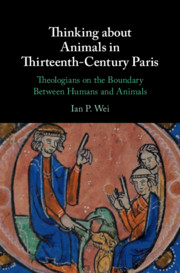 Thinking about Animals in Thirteenth-Century Paris
Thinking about Animals in Thirteenth-Century Paris 3 - Albert the Great and Thomas Aquinas
Published online by Cambridge University Press: 07 August 2020
Summary
Chapter 3 considers the work of two Dominicans, Albert the Great and Thomas Aquinas. Albert placed humans at the top of a hierarchy. He saw many similarities between animals and humans, the likeness diminishing with every step down the hierarchy. Although a hard boundary between humans and animals remained, it was just one of many that divided animals into categories, the pygmy from the human, the monkey from the pygmy, and so on. In the Summa theologiae Aquinas consistently stressed differences between humans and animals, but also noted significant similarities. Even if they could not grasp universals, for example, some animals could nevertheless think generally about types of other animal. Aquinas’s earlier work, the Summa contra gentiles, was especially imaginative in the way it explored the relationship between similarity and difference. Within the hierarchy of being, for example, he showed how difference might be generated by similarities in a variety of ways. Aquinas took an entirely different approach, however, when he set aside every aspect of the human which was in any way similar to the animal, concluding that contemplation of the truth was the sole feature that defined the human absolutely.
Keywords
- Type
- Chapter
- Information
- Thinking about Animals in Thirteenth-Century ParisTheologians on the Boundary Between Humans and Animals, pp. 145 - 200Publisher: Cambridge University PressPrint publication year: 2020


